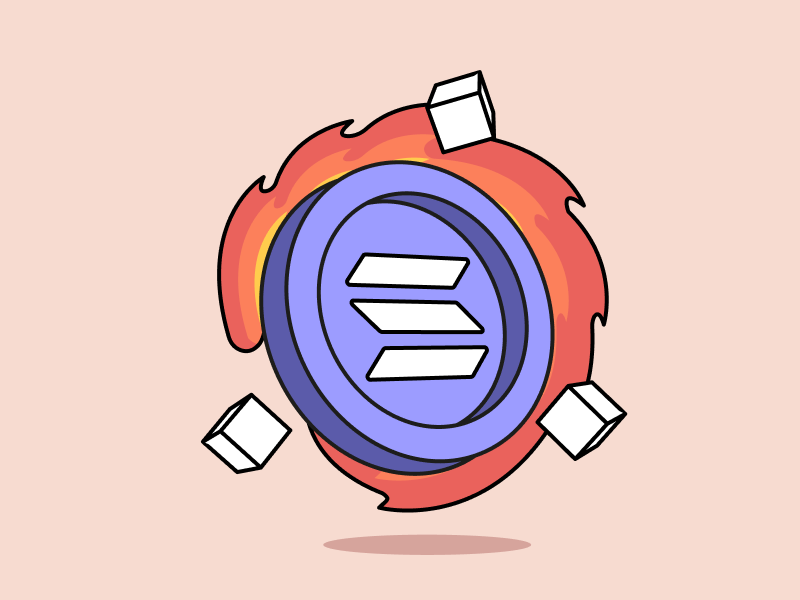Solana is one of the crypto projects that became a winner in the 2021 bull market. SOL manage to rise dramatically from a price of $3 dollars in early 2021 to around $240 dollars at the peak of the bull market. Solana is now considered one of Ethereum’s biggest competitors. However, a lot of performance improvements still need to be made. Solana has had several system failures leading to shutdowns for several hours. One of the significant network updates in the making is the Solana Firedancer. Firedancer is an attempt to eliminate major flaws in the Solana system while improving the performance and scalability of the network. So, what is Solana Firedancer? How does it work and what impact does it have on the Solana network? This article will explain it in detail.
Article Summary
- 🧠 Solana saw a significant increase during the 2021 bull market with SOL increasing from $3 to around $240. Although the asset underwent a drastic decline in the bear market, Solana still has a high number of daily active addresses and daily transactions.
- ⚙️ Firedancer is a new validator application/client for the Solana network developed by the Jump Crypto team. So, it provides an alternative to the Solana Labs validator client and aims to improve the security, decentralization, and performance of the Solana network.
- 💻 The presence of Firedancer means that no validator client has full control of the network, which improves decentralization and prevents total shutdown of the network. In early testing, Firedancer successfully boosted Solana transactions to 1.2 million per second or 600,000 after deduplication.
- 📈 The potential impact of Firedancer includes significantly better Solana performance, network stability, increased security, and opening up new use cases. If Firedancer is successful and Solana can reach 1 million transactions per second, it could open up new use cases such as CEX-like speed for DEX and GameFi.
What is the Current Status of the Solana Network?
Solana is a blockchain network that serves as a platform for various smart contract-based applications. Solana was created by Anatoly Yakovenko and Raj Gokal in 2018. The native crypto asset of the Solana network is SOL. Currently, Solana is home to hundreds of crypto applications such as NFT marketplace, DeFi, and GameFi.
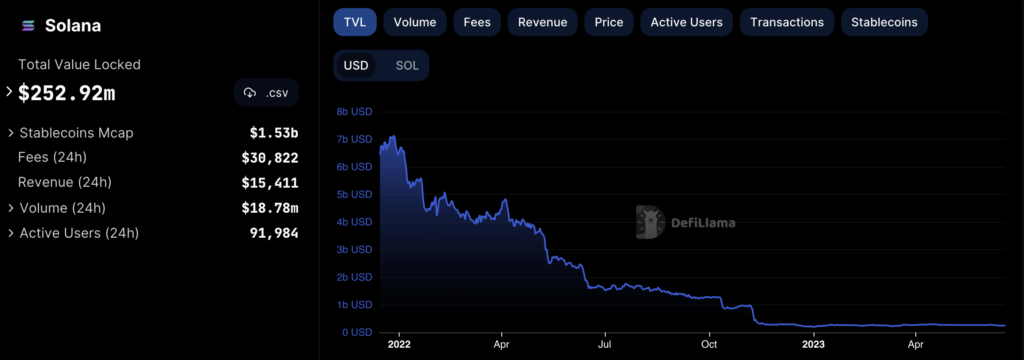
Solana’s total volume locked (TVL) has been on a prolonged downward trend since early 2022. This decline coincided with the crypto bear market. In addition, Solana was, unfortunately, part of the November 2022 crash of FTX, a major exchange in the US. FTX had various ties to Solana, including being a large investor in the SOL coin. You can see two downward dives on the TVL chart after October 2022.
The SOL coin also suffered the same fate. The SOL coin experience a drastic correction from a high of $240 dollars in the bull market to $9.8 dollars by the end of 2022. Again, this price correction was influenced by the FTX event which caused a drop of more than 60%.
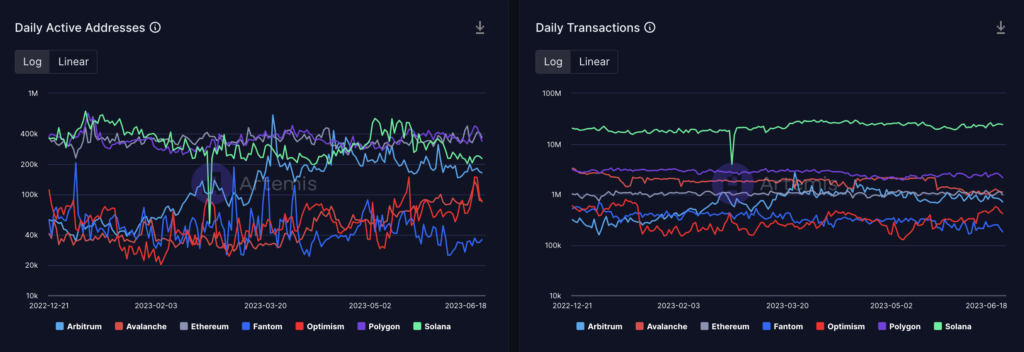
However, the fundamental numbers of the Solana network tell a different story. Fundamental numbers such as daily active addresses and daily transactions are still high. Solana’s daily active address count is only beaten by Ethereum and Polygon while Solana’s daily transaction count is the highest when compared to other L1s such as Fantom, Avalanche, and Ethereum. In developer activity, Solana has around 461 weekly active developers and 3,639 commits per week. This puts Solana’s developer activity at number 3, below Polkadot and Ethereum.
So, Solana clearly still has a lot of users and a very active developer ecosystem. Solana also announced various things at the event Solana Breakpoint at the end of 2022. One of them is the Solana Firedancer.
What is Solana Firedancer?
Firedancer is a new validator application/client for the Solana network. Jump Crypto is the team behind Firedancer and Firedancer is written in the C/C++ programming language (Solana Labs validator client uses Rust). So, The main goal is to provide an alternative to the Solana Labs validator client, which is written in Rust. Firedance will also improve the security, decentralization, and performance of the Solana network.
Any blockchain with a validator system will have applications/clients that validators use to process transactions. Ethereum has four consensus clients and four execution clients. The more validator clients, the more stable and decentralized a network is.
With Firedancer, two different validator clients can validate transactions simultaneously. This reduces the impact of bugs on the network. If a bug occurs in one of the validator clients, the network will still function. Solana can still operate with one functional validator client but at a lower level of security and decentralization.
Furthermore, the addition of Firedancer means that no single validator client has full control of the network. This increases network decentralization and prevents network shutdowns (Since June 2022, there have been four Solana shutdowns). Firedancer provides an alternative client validator so validators can simply switch their client if a problem occurs.
Finally, Firedancer improved Solana’s network performance. In the initial testing phase (quoted from the tweet above), Firedancer can boost Solana’s transactions to 1.2 million per second or 600,000 after deduplication. If that number is achieved, Solana will become the fastest blockchain. So, why would the creation of a new validator client have such a significant impact? We will explain how Firedancer works below.
How Does Solana Firedancer Work?
Central to the operation of a blockchain network is the communication between validator nodes. Validator clients are software run by validators that serve as a platform for processing transactions. Firedancer is basically a new software that all validators on the Solana network can use.
In the Solana network, each validator is responsible for fulfilling the following four functions:
- Transaction Propagation: Sending transaction data from users to the lead validator in the Epoch / receiving data as a lead validator.
- Processing: Runs computation to process transactions as well as update and manage network status.
- Transaction Broadcasting: Broadcasts transactions to all network validators.
- Verification: Verifies the validity of the transaction and performs finalization.
The four functions above are of course just a simplification of the transaction process in Solana. However, in general, each validator must perform all four functions. Firedancer clients must be able to do all of them. Therefore, the development team at Jump Crypto decided to release Firedancer component-by-component to the public.
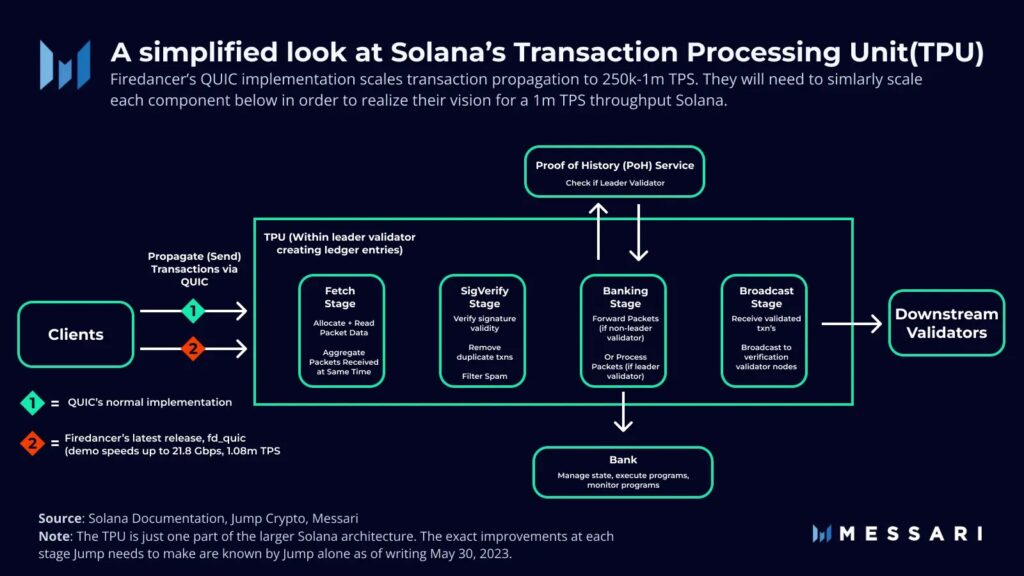
The latest news from the Jump team is the implementation of fd_quic, a modification of the QUIC protocol that Solana just implemented in early 2023. QUIC is basically a protocol for the transaction propagation stage where validators have to communicate with the lead validator (in charge of creating blocks).
The QUIC protocol is implemented by Solana to fight abusive behavior in the form of bot transactions. With QUIC, Solana validators can regulate the flow of incoming transactions to prevent network congestion.
In testing the fd_quic protocol, the Jump team managed to reach a speed of 1 million TPS using 4 CPU cores. This type of hardware is far below the Solana validator recommendation that requires a 12-core CPU. So, Firedancer was able to achieve this by updating the load balancing (spreading the transaction processing load) in hardware and software. These two load-balancing updates are Receive-Side Scaling (RSS) alongside data structure and algorithm optimizations.
However, as in the image above, Jump has just implemented one Firedancer component. To create a new validator client, Firedancer needs to modify all components in Solana’s transaction process. With a very ambitious goal of 1 million transactions per second, Firedancer has the potential to be “the merge” moment for Solana.
Firedancer Potential Impact on Solana
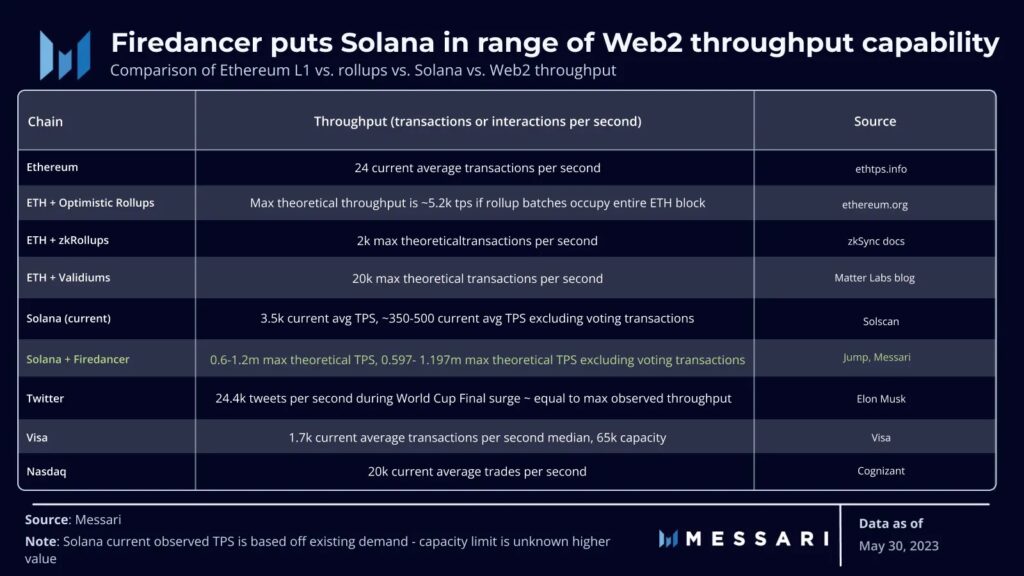
- Solana Performance Enhancements: Firedancer will improve every aspect of Solana network performance. Firedancer is targeting a speed of 1 million transactions per second on Solana. This will position Solana as one of the fastest blockchains.
- Increasing Network Stability: With the Firedancer client, validators can switch between using Firedancer or Solana Labs. This increases the stability of the network and prevents total shutdowns that have occurred several times in Solana.
- Improving Security: The existence of Firedancer increases the decentralization of Solana’s validator client. Validators will be naturally distributed between Solana Labs’ and Firedancer’s clients. This increases security as hackers and attackers cannot directly attack both validator clients.
- Opening Up New Use Cases: If Firedancer is successfully deployed and Solana’s TPS reaches 1 million, it opens up many use cases for Solana. The high TPS and low network latency will make Solana ideal for a variety of uses such as fast decentralized crypto exchanges and crypto-based games.
Conclusion
Solana was founded by Anatoly Yakovenko and Raj Gokal in 2018 and is now home to hundreds of crypto applications. SOL experienced significant price gains during the 2021 bull market and is considered Ethereum’s strongest competitor. Even so, Solana needs to make many performance improvements as it suffers from frequent system failures. One significant update is Solana Firedancer, an attempt to eliminate Solana’s major weaknesses and improve its network performance and scalability.
Firedancer is a new validator application/client for the Solana network developed by Jump Crypto. Additionally, Firedancer aims to provide an alternative to the Solana Labs validator client and improve the security, decentralization, and performance of the network. Initial testing shows Firedancer can increase Solana transactions to 1.2 million per second.
Firedancer can also provide network stability by providing alternatives in case of client bugs and improve security by decentralizing validator clients. In addition, if Solana’s TPS can reach 1 million successfully, this could open up a variety of new use cases for Solana, including fast decentralized crypto exchanges and crypto-based games.
How to Buy SOL Coin in Pintu
You can start investing in SOL coins and buy them on the Pintu app. Here is how to buy crypto on Pintu:
- Create a Pintu account and follow the process of verifying your identity to start trading.
- On the homepage, click the deposit button and top up the Pintu balance using your preferred payment method.
- Go to the market page and look for SOL.
- Click buy and fill in the amount you want.
- Now you are a crypto investor!
In addition, the Pintu application is compatible with various popular digital wallets such as Metamask to facilitate your transactions. Go and download the Pintu cryptocurrency app on Play Store and App Store! Pintu is regulated and supervised by Bappebti and Kominfo.
You can also learn crypto through the various Pintu Academy articles which are updated every week! All Pintu Academy articles are for educational purposes, not financial advice.
References
- Kelxyz, Solana: Firedancer Overview And Unlocks, Messari, accessed on 19 June 2023.
- Ian Greer, How Solana Will Scale to 1 Million TPS (Jump Crypto Firedancer), Iangreer.io, accessed on 20 June 2023.
- @kelxyz, “1/ The first bitcoin halving. The Merge. The next big tech shift? Firedancer. Jump Crypto’s developing validator client”, Twitter, accessed on 20 June 2023.
- @xkonjin, “@solana 1️⃣ Firedancer focuses on optimizing transaction propagation, processing, broadcasting, and verification.”, accessed on 20 June 2023.
- Solana Network Upgrades, Solana, accessed on 20 June 2023.
- @jump_firedancer, “Introducing Firedancer’s latest technical milestone: fd_quic 🔥💃 A high-performance implementation of the QUIC, accessed on 21 June 2023.
